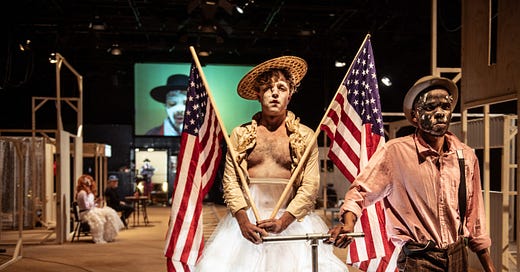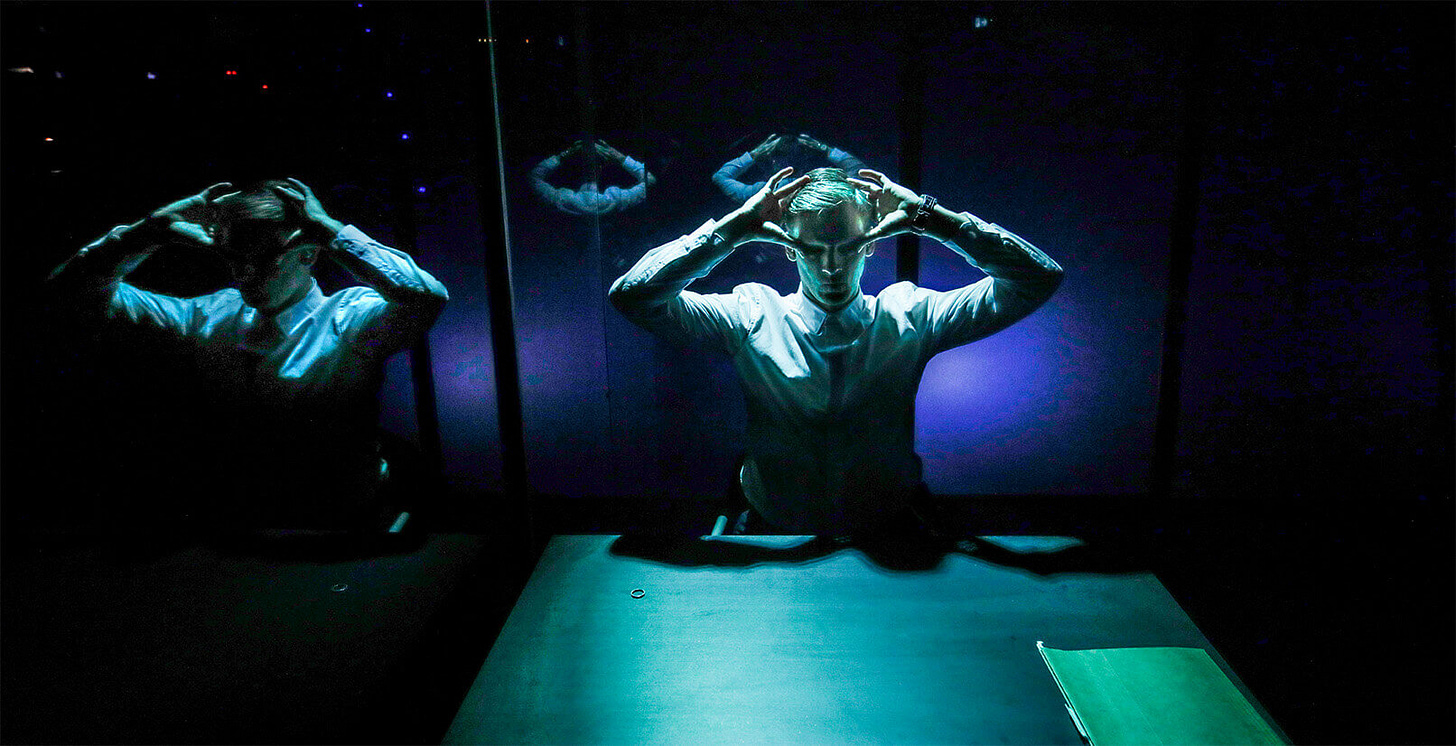Wild, Wild West: Dark Noon and the #DANISH showcase
A look at some of the Danish work at this year's Edinburgh Festival Fringe
Welcome to Café Europa, a new weekly newsletter dedicated to European theatre. You can expect a mix of in-depth reviews and profiles of the artists and companies that excite me, plus festival coverage and other stuff.
I’m still finding my way around the platform, but if you think this kind of coverage would be of interest to people you know, please do spread the word. And if you enjoy reading this newsletter and want to support me you can do so via my Ko-fi account.
Having said all of that, I’m going to kick off this newsletter by talking about work I saw in Edinburgh. Arguably the stand-out show at this year’s fringe was not homegrown. It was a Danish take on American history filtered through a South African lens.
I’ve long been fascinated with the company FIX+FOXY. Their work is the antithesis of comfortable. In fact, if you wanted to reduce their work under one handy umbrella term it would be ‘uncomfortable encounters’.
Founded in 2008, FIX+FOXY’s early work was about challenging perceptions and working with people whose stories are not only not told on stage, but who are less than visible in society, the people we choose not to see. In his essay Hostages of Me (which I would very much recommend), director Tue Biering observes that the company’s work includes very little “’feel-good no-harm drama,” instead they make work drawing on popular culture that shifts form from show to show. There is no fixed FIX+FOXY method, they just hope you’ll leave their shows marked in some way.
Early shows include Pretty Woman, in which they paid a sex worker every night to play the role of Vivian in a re-enactment of the popular movie which took place inside a shipping container, and Friends: The One with the Asylum Seekers and Some Rejected Ones in which they cast asylum seekers from camps around Copenhagen in the roles of the six friends. Was this exploitative or true inclusion? Does the fact I’m even thinking along these lines reveal something about my own presumptions? The shows forced their audiences to ask questions of the work and themselves.
Participatory elements have crept into their work over the years. In Welcome to Twin Peaks: Eight Cars in a Remote Area of Civilisation, their take on David Lynch’s cult classic, audience members were driven around a community in Denmark, meeting different characters as part of their journey.
Last year they brought Rocky! to Zoo Southside, a one-man show ostensibly inspired by Stallone’s iconic 70s’ boxing movie and the whole idea of the loser’s narrative, that starts out as a conventional monologue and morphs into, well, something else entirely. By the end we’ve watched the performer beating a pig carcass with a baseball bat (I still find myself thinking about the backstage logistics of the dead pig) before suspending himself by his ankles, upside down and completely naked, from the ceiling, like a piece of meat. This show baffled and enraged more than one person with whom I spoke to about it. It was unapologetic and distressing but also kind of thrilling.
This year the company scored an unexpected fringe hit with their 2019 show Dark Noon, a journey through American history told through the lens of western movies, presented as part of the Pleasance’s programme at the EICC.
The story Biering initially set out to tell with Dark Noon ended up shifting considerably over the course of the creation process. Having assembled a team of performers from Johannesburg with quite a different project in mind, once he started talking to them about what he hoped to achieve, he was forced to rethink and reconceptualise the show. As he describes in Hostages of Me:
After assembling a team of amazing players with our co-director-choreographer Nhlanhla, we did several workshops exploring the relationship between South African society and the universe of the Western. There were many things that made sense, but I had a sneaking feeling that I was reproducing a character I didn’t like. Here we came and asked them to tell us about themselves. Like it has happened many, many times before. “Tell me a story from Africa.” After a few days with that feeling, I started a trial by hesitantly introducing the idea that instead of telling their own story, they should tell my story. I was quite unsure if this was the wrong thing to suggest, but it immediately seemed that everyone was relieved. The team of actors agreed that it was the first time they had been invited to play “the others”. A new energy and work that became much more interesting began.
The focus shifted from Africa to America, and on the experience of having grown up on and internalised a version of American made by the victors.
The stage is naked at the start of Dark Noon, a square of red earth with the audience arranged around three sides. A huge screen fills the back wall on to which the actors’ faces are projected in close-up. We watch as the ensemble don crude white-face make-up and blonde wigs. We watch as the native people are wiped out by violence and disease, both imported by migrants themselves fleeing poverty and desperation in hope of something better.
The show is broken down into titled episodes (with titles like Little House on the Prairie, Settlers vs. Natives, and The Genocide) as, slowly, the land is built upon. Stacked against the side of the stage are various wooden flats. The actors use these to erect the frames of buildings on the stage; firstly, a homestead, then a church, a shop, a bank (which promptly gets robbed the minute it opens). A small town starts to take shape on the stage. Watching this process, I was reminded of Deadwood, the excellent HBO show which distilled the American project down to one combative mid-west town, which expanded over the course of the show – by season three they even had a theatre.
Over its 100-minute run-time, we witness the gold rush, the coming of the railroad, and the creep of capitalism. Every few minutes someone whips out a gun and a body hits the dirt. Slaughter is commonplace. A metal fence is erected around the native people.
Is this sometimes uncomfortable? Absolutely. But that’s intentional. The conquest of the indigenous peoples of America is depicted as a sports game complete with onscreen scoreboard and much whooping. The actors use cameras to film each other’s faces, which are shown in extreme closeup on the back wall. During the sports commentary sequence the camara zooms in not just on the actor playing the announcer but also on the audience member sitting on the bench next to him, hyper-aware of her face on the screen.
Increasingly the audience is drawn into the action. People are invited on stage to participate. These become part of the production, part of the on-stage settlement. In one of the show’s most ingenious moments, cans of Coca-Cola are doled out to those who want them. They are gratefully accepted only for the actors to turn around and demand payment. There are no hand-outs here. That’s capitalism, baby.
At the end of the show, the actors personalise what we have just seen, discussing their own experiences of watching westerns growing up, of being fed this romantic, sanitised narrative of the American West through their TV screens. This adds a necessary layer to the show, explicitly examining the way dominant cultural narratives shape our world.
Dark Noon was presented as part of the #DANISH showcase. But I think it’s interesting that this was not on at Zoo or Summerhall but was instead co-produced by Acheaton, Glynis Henderson Productions, (the company who brought Stomp to the UK) and the Pleasance. In terms of both run-time and scale, it’s an anomaly on the fringe as it currently exists, a bold choice but one that seemed to be paying off. I know of people who returned a second time hoping to be more actively involved, which I guess makes sense on an experiential level (snag a seat on one of the benches if you want a more participatory experience) but I also find a little strange given the unrelenting focus on brutality and bloodshed, and that one moment of interaction evolves into a slave auction.
As in their previous work the company constantly prod at what is permissible on stage, demolishing comfort zones and forcing the audience to interrogate what they are watching and their own response to it.
Inside the box
The other #DANISH showcase show I saw this year was Teater Katapult’s The Insider, a technically impressive, one-man account of the cum-ex fraud scandal (which I admit I had not heard of before, though have since heard referenced twice in different contexts). This enormous case of financial fraud involved a network of banks exploiting loopholes in international tax law. This allowed them to falsely claim multiple dividend tax rebates on the same shares, resulting in more than $60 billion being stolen from the treasuries of Denmark, Germany and other countries.
Performer Christoffer Hvidberg Rønje, who spends the majority of the show encased in a glass-walled box, plays a whistle-blower who helps blow the scandal wide open. It’s a very physical performance. He sweats and strips and bellows as he recounts his initial seduction into the scheme and eventual breakdown. The box, designed by Signe Krogh, is at once a gleaming corporate office space and interrogation room. A flashy mix of projections, lighting and sound design transport us through different environments from banking firm to nightclub to A&E department as the protagonist unravels. Trees bloom and tower blocks loom across the back walls. Rønje uses marker pens to draw on the walls of the cubicle to help explain the financial stuff and the dialogue is delivered via binaural headphones, giving it a sort of distorted intimacy, with every small sound – every scritch, every breath - amplified.
Written by Anna Skov Jensen and directed by Johan Sarauw, the show is undeniably ambitious from a technical standpoint, but for me it never quite matched the mix of theatrical pizzazz and character insight achieved by something like Lucy Prebble’s Enron, and though everything about the production seemed to be striving for an intense, claustrophobic experience, I felt oddly ungripped in places. Theatre that explains complex concepts to me in exhilarating ways is one of my favourite subgenres, but while I admired the show in many ways, I felt all the wizardry sometimes created a barrier. For balance, here’s Fergus Morgan’s review in The Stage where he called it “a slick, sopisticated European theatre version of The Wolf of Wall Street.”
Thanks for reading! This has been the first edition in what will be a weekly newsletter. Across the next few weeks/months I hope to write about work from Belgium, Kosovo, Germany, Serbia and Hungary. I’d love to hear your feedback. You can email me on natasha.tripney@gmail.com. Or you can find me on Twitter. Or Instagram where I (predictably) post under IntervalDrinks.





